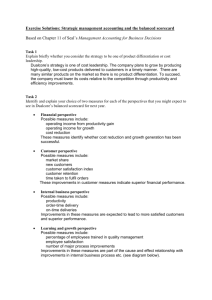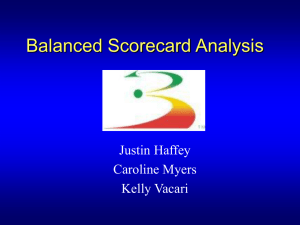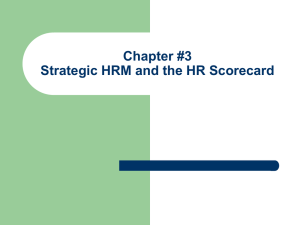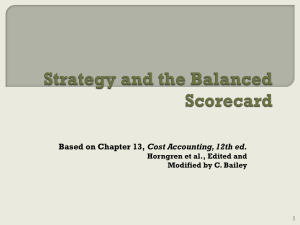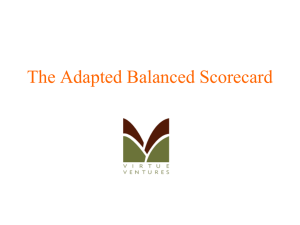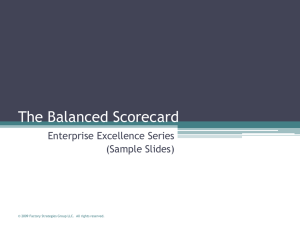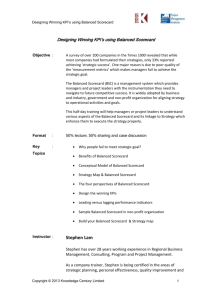To Balanced Scorecard or Not to Balanced Scorecard, That is The
advertisement
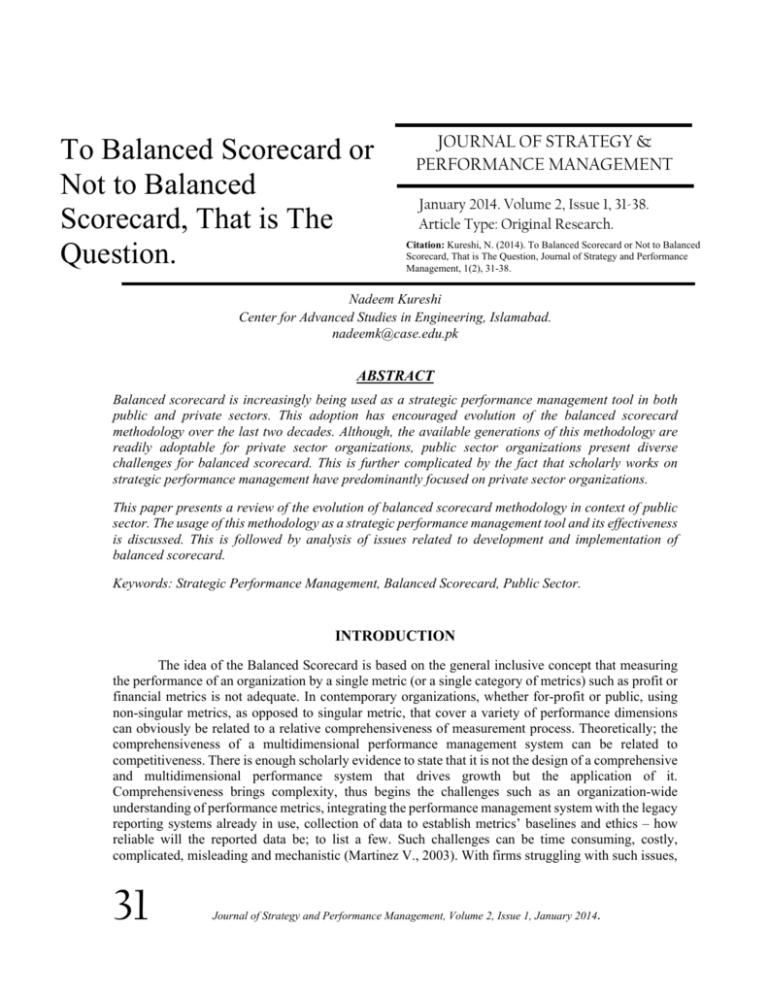
To Balanced Scorecard or Not to Balanced Scorecard, That is The Question. JOURNAL OF STRATEGY & PERFORMANCE MANAGEMENT January 2014. Volume 2, Issue 1, 31-38. Article Type: Original Research. Citation: Kureshi, N. (2014). To Balanced Scorecard or Not to Balanced Scorecard, That is The Question, Journal of Strategy and Performance Management, 1(2), 31-38. Nadeem Kureshi Center for Advanced Studies in Engineering, Islamabad. nadeemk@case.edu.pk ABSTRACT Balanced scorecard is increasingly being used as a strategic performance management tool in both public and private sectors. This adoption has encouraged evolution of the balanced scorecard methodology over the last two decades. Although, the available generations of this methodology are readily adoptable for private sector organizations, public sector organizations present diverse challenges for balanced scorecard. This is further complicated by the fact that scholarly works on strategic performance management have predominantly focused on private sector organizations. This paper presents a review of the evolution of balanced scorecard methodology in context of public sector. The usage of this methodology as a strategic performance management tool and its effectiveness is discussed. This is followed by analysis of issues related to development and implementation of balanced scorecard. Keywords: Strategic Performance Management, Balanced Scorecard, Public Sector. INTRODUCTION The idea of the Balanced Scorecard is based on the general inclusive concept that measuring the performance of an organization by a single metric (or a single category of metrics) such as profit or financial metrics is not adequate. In contemporary organizations, whether for-profit or public, using non-singular metrics, as opposed to singular metric, that cover a variety of performance dimensions can obviously be related to a relative comprehensiveness of measurement process. Theoretically; the comprehensiveness of a multidimensional performance management system can be related to competitiveness. There is enough scholarly evidence to state that it is not the design of a comprehensive and multidimensional performance system that drives growth but the application of it. Comprehensiveness brings complexity, thus begins the challenges such as an organization-wide understanding of performance metrics, integrating the performance management system with the legacy reporting systems already in use, collection of data to establish metrics’ baselines and ethics – how reliable will the reported data be; to list a few. Such challenges can be time consuming, costly, complicated, misleading and mechanistic (Martinez V., 2003). With firms struggling with such issues, 31 Journal of Strategy and Performance Management, Volume 2, Issue 1, January 2014. there seems to be a shift of focus from development of performance management model to actual deployment of such models and efficacy of metrics (Franco and Bourne, 2003). This shift in scholarly investigation brought in light the phenomenon referred to as the knowing-doing gap (Pfeffer and Sutton 1999) or the performance paradox (Cohen 1998). Johnson et al. (2002) have pointed the caveat of management getting deluged with the complexity of measurement system and therefore becoming unable to actually drive performance through implementing the measurement system. They have reported that the organizations focusing their performance management efforts on only the “good-enough” rather than the detail. They relate success to an ability of management to see their business in “simple terms” and their “understanding of key drivers of their business”. The above situation represents a fundamental business dilemma; to seek comprehensiveness of performance metrics or not to? Where to stop knowing only and start doing? This dilemma can become multifolded in public sector service organizations since a predominant body or literature related to performance management appears to focus on manufacturing and industrial sector (Ittner and Larcker, 1998; Johnsen, 2001; Radnor and Lovell, 2003; Eskilden et al., 2004; Moxham and Boaden, 2005). In addition, many studies have reported that transporting performance management systems from private sector to public service sector can be little effective appropriate adjustments are made (Kaplan, 2001; Radnor and McGuire, 2004; Moullin, 2004; Wisniewski and Stewart, 2004; Adcroft and Willis, 2005; Pidd, 2005). The extreme shape of this dilemma will obviously confront the managers of public sector service organizations that offer a multitude of diverse services such as a single organization offering public services such as health, education, housing, transportation, security etc. The above arguments, however, do not challenge the efficacy of performance measurement through balanced scorecard. Empirical evidence suggests that the use of balanced scorecard provide a vehicle for the organizations enabling their employees to recognize their part in moving the organization forward and thus support organisational strategy (See for example, Greatbanks and Tapp 2007). DEVELOPMENT OF BALANCED SCORECARD There seem to be three distinct channels of development of performance measurement through scorecard system. The first one, distinguishable from Kaplan and Norton balanced scorecard, is based on instinct of nature and has always been around. It is only natural to seek balance. The underlying thought of multi-dimensionality of performance measurement can even be found in religious texts, seeking a balance in human behavior. In business settings, scorecard based management has evolved through four different phases; moving from a collection of metrics that can be grouped into financial & operational; to more comprehensive groups of performance metrics moving down to employees level (Brown 2007). The second is the development of Kaplan and Norton Balanced Scorecard which moved through at-least four distinguishable “generations” moving from a simple collection of measures under perspectives to a relatively comprehensive performance management system encompassing external perspectives and cultural issues related to balanced scorecard (Kaplan and Norton 1992). Since then, a third channel seems to have evolved from firms offering consultancy in performance management, offering newer generations of balanced scorecard (See for example; Balanced Scorecard institute USA and Palladium Group USA). These consultancy firms also seem to be generating fairly reliable, high level success stories of Balanced Scorecard. Journal of Strategy and Performance Management, Volume 2, Issue 1, January 2014. 32 The early evidence of adoption of balanced performance measurement in public sector seems to be coming from USA, starting from the Hoover Commission of 1949, proposing Performance Budgeting. This was followed by many initiatives. However, public sector agencies in USA were actually required to strategically plan their operations and link it to stakeholders’ value through the famous Government Performance and Results Act (GPRA) of 1993. Many other subsequent US public policies (See for example: Federal Acquisition Streamlining Act of 1994, the Government Management Reform Act of 1994, and the IT Management Reform Act of 1996, etc) required measurement of performance of public sector organizations to judge their effectiveness in fulfilling their chartered roles. USE OF BALANCED SCORECARD The scholarly evidence of use of balanced scored system was initially provided by Silk (1998), reporting through estimation that 60% of USA Fortune 500 companies have either implemented or are managing their business through balanced scorecard. While the emergence of the balanced scorecard phenomenon remained in USA initially, it soon spread around the world. Martinez (2005) reported that the utilization rate of balanced scorecard around the world is 44%, with 57% of UK companies, 46% of USA companies and 26% of German & Austrian companies use Balanced Scorecard. Worldwide 81% North America 98% South America 95% Europe 71% Asia 65% Figure 1: Use of Strategic Planning as a management tool (Data from Rigby 2001) However, the reported statistics are not essentially for the Kaplan and Norton series of Balanced Scorecard but a general adoption of the methodology. The figure from USA is based on Rigby (2001), which also reports that 88% of businesses worldwide use strategic management in one form or another. Figure 1 shows a selected summary of use of strategic management by global economic regions. Rigby reported that the most widely used management technique used in businesses in Europe and Asia is Benchmarking (77% and 70% respectively). EFFECTIVENESS OF BALANCED SCORECARD The data reported on the effectiveness of Balanced Scorecard predominantly remains anecdotal in nature. While many instances are available, linking use of Balanced Scorecard to increased bottomline performance, exact results are usually not available owing to proprietary factors in private sector. Similarly data security needs of public sector organizations have been cited as one of the reasons of non-reporting of empirical success. While analyzing the success, it also needs to be kept in view that most Balanced Scorecard initiatives do not come alone. They accompany several other performance improvement initiatives, together attributable to the status quo dis-satisfaction and dynamism of top management. As reported in Rigby (2001), the mean satisfaction ratings of Balanced Scorecard as a management tool stands at 3.85 on an ascending scale of 5, ranked below other tools such as One-to- 33 Journal of Strategy and Performance Management, Volume 2, Issue 1, January 2014. one marketing (4.09), Cycle Time Reduction (4.06), Pay-for-Performance (3.97) and Strategic Planning (3.93). Balanced Scorecard has scored higher than other management tools such as Knowledge Management (3.02), Core Competencies (3.61), Reengineering (3.66), Supply Chain Integration (3.75), Outsourcing (3.77) and TQM (3.82); as reported in Rigby (2001). In a more recent study published on internet by Bain & Company (Rigby 2011), it has been reported that the usage of Balanced Scorecard by firms has increased from approximately 35% to 53%; from 1996 to 2008. Interestingly, the usage has been reported as approximately 70% in 2006. The same work reports that the satisfaction level of firms with the results of balanced scorecard has remained approximately at 3.8 on an ascending scale of 5 from 1996 to 2008, with little variation. The lowest satisfaction rating coincides with the highest usage year; approximately 3.5 in 2006. The abovementioned figures, however, should be used with caution while judging the efficacy of Balanced Scorecard generally and in Public Sector organizations particularly since the techniques scoring higher in usage and satisfaction ratings do not generally apply to public sector. In addition, the figures of the earlier study may have become anachronistic keeping in view the rather rapid recent evolution of Balanced Scorecard since the study was conducted. In its latest “versions” Balanced Scorecard seems to have encompassed many other management tools in itself, such as Strategic Planning, Knowledge Management, Customer Satisfaction Measurement, Supply Chain Integration; to name a few. PROBLEMS WITH IMPLEMENTED BALANCED SCORECARDS Dinesh and Palmer (1998) have compared and contrasted Management By Objectives (MBO) and Balanced Scorecard, both aligning an organization’s tangible objectives with strategy. They have reported that the roots of both the management philosophies converge to the same idea. They outlined two problems that underlined MBO and its implementation: Partial Implementation. Development of Goals without consulting all stakeholders. They forecasted that Balanced Scorecard will suffer from the former problem of partial implementation. The increased pace of business and fierce competitiveness encourages this; as described in the management dilemma discussed earlier in this paper. They however, concluded that balanced scorecard may not suffer the later problem because of increased influence of TQM which encourages collaboration. Problems in developing the Balanced Scorecard Lack of decision-making aids for generating strategic goals, measures and targets. Over-complexity of too many cause-and-effect chains. Problems in Derivation of reliable future-orientated statements due to Lack of predictability regarding lifecycle development. Lack of scholarly literature on developing balanced scorecard. Problems in using the Balanced Scorecard Journal of Strategy and Performance Management, Volume 2, Issue 1, January 2014. 34 Amount of Time and Energy required in recording and monitoring the defined measures Non-Acceptance of new measures alongside the numerous measures already present Table 1: Problems in developing and using Balanced Scorecard Ahn (2001), reporting the results of a pilot project of balanced scorecard implementation in ABB Industrie AG, Switzerland has outlined a range of difficulties faced during development and usage of balanced Scorecard. Table 2 provides and abridged summary. The report by Ahn (2001) confirmed the warning given by Weber and Schäfer (2000) that Balanced Scorecard requires more management capacity than expected. A study by American Productivity & Quality Center (APQC) reported that of the 80 companies investigated regarding scorecards and performance measures, 24% tracked only accounting and operations. 28% of 76% (that were more balanced) described their scorecard as balanced though their initiatives were not strictly using the Kaplan and Norton perspectives. The study narrowed the scope by selecting best 5 companies having the most balanced scorecards (relatively) including Bank of America, Saturn, LL Bean, Crown Castle and Jet Blue. The reported results suggest that there are no scorecards in a shape that did into need further refinement. Even the best performing companies on BSC are struggling in coming up with best metrics to drive employee behavior & decision making. Brown (2007) has reported a list of top ten problems with most scorecards. Table 2 summarizes the problems, in the same order. It is obvious that these problems relate to both the private and public sector equally. The findings of Ahn (2001) and Brown (2007) have confirmed the skepticism expressed by Dinesh and Palmer (1998) and Weber and Schäfer (2000). The challenge seems to be even harder since diverse challenges of implementing balanced scorecard may not completely utilize the benefits of other management systems such as TQM. This is particularly relevant since Balanced Scorecard is often compared and contrasted with initiatives such as TQM and ISO 9000 (Rigby, 2001), rather than building upon them. Balanced Scorecard has been criticized for not having an inherent ability to address risks that threaten achievement of strategic objectives. Some public sector organizations such as Australian Navy have built a framework of Corporate Risk Management on top of the Strategic Objectives and KPIs framework of a typical Balanced Scorecard. Similarly, there is no evidence that Balanced Scorecard is being used as a comprehensive performance management system (Kureshi, 2013). Even in organizations using it for more than a decade, other performance management tools such as behavioral evaluation etc. are being used simultaneously. WAY AHEAD It can be seen from the above review that balanced scorecard methodology has lived through various problems and continues to evolve. Particularly in the context of public service sector, this methodology requires extreme caution at both design and implementation levels due to the many diverse challenges such as: 35 Journal of Strategy and Performance Management, Volume 2, Issue 1, January 2014. Compatibility with legacy management systems in use The challenge of doing it quickly (in one management change cycle) Organization wide understating of metrics Acceptance of a new performance management system by employees Ethics in reporting performance Lack of linkage between service benefits and performance metrics The managers’ dilemma; seeking a balance between the comprehensiveness of balanced scorecard and time & resource constraints. Ability to address risks that threaten achievement of strategic objectives. Obviously many remedies are suggested in contemporary literature for the issues discussed above. Many scholarly works (See for example Brown 2007, Bititci et al. 2005) have reported best practices from case studies and consultancy experiences. However, as discussed at length in this paper, public sector balanced scorecards require significant work and available literature and consultancy remains only general guides. The general findings discussed in this work are a part of an ongoing study of balanced scorecard implementation in public sector. The following works are expected to emanate as this work continues: 1 2 3 4 5 6 7 8 9 10 Integration of general management tools such as HRM, TQM etc. with balanced scorecard. Reporting of specific findings of the study. Effectiveness of public sector application of different generations of balanced scorecard. Most metrics are lagging Scorecards can not measure ethics Alignment of goals, strategies and metrics remains a problems Most scorecards remain at senior management level Awards and punishments are not linked to metrics Most targets are set arbitrarily Customer satisfaction metrics are rudimentary Human Resource metrics are least effective Balanced scorecard reporting still uses traditional tools such as power point & spreadsheets Scorecards do not use external factors Table 2: Top 10 problems with scorecards REFERENCES Adcroft, A. and Willis, R. (2005), The (un)intended outcome of public sector performance measurement, International Journal of Public Sector Management, 18(5), 386-400. Ahn, H. (2001), Applying the Balanced Scorecard Concept: An experience Report, Long Range Planning, 34, 441-461. Journal of Strategy and Performance Management, Volume 2, Issue 1, January 2014. 36 Bititci. U. S., Mendibil, K., Martinez, V., and Albores, P. (2005), Measuring and managing performance in extended enterprises, International Journal of Operations & Production Management, 25(4), 333-353. Brown, M. G. (2007), Beyond Balanced Scorecard: Improving Business Intelligence with Analysis, Productivity Press. Dinesh, D. and Palmer. E., (1998) Management by objectives and the Balanced Scorecard: will Rome fall again?, Management Decision, 36(6), 363-369. Eskildsen, J.K., Kristensen, K. and Juhl, H.J. (2004), Private versus public sector excellence, TQM Magazine, 16(1), 50-6. Franco, M. and Bourne, M. (2003), Factors that play a role in managing through measures, Management Decision, 41(8), 698-710. Greatbanks, R. and Tapp, D. (2007), The impact of balanced scorecards in a public sector environment Empirical evidence from Dunedin City Council, New Zealand, International Journal of Operations & Production Management 27(8), 846-873. Ittner, C.D. and Larcker, D.F. (1998), Innovations in performance measurement: trends and research implications, Journal of Management Accounting Research, 10, 205-38. Johnsen, A. (2001), Balanced scorecard: theoretical perspectives and public management implications, Managerial Accounting Journal, 16(2), 319-30. Kaplan, R. S. (2001), Strategic performance measurement and management in nonprofit organizations, Nonprofit Management and Leadership, 11(3), 353-70. Kureshi, N. (2013). All well with your Performance Management system? Perhaps not! Journal of Strategy and Performance Management, 1(1), 4-7. Martinez V (2003) Managing value creation - the 'value matrix and the value cube' frameworks to describe and create value. Improving Business Performance Conference, Glasgow. Moullin, M. (2004), Using the public sector scorecard in health and social care, Proceedings of the Performance Measurement Association Conference, Edinburgh. Moxham, C. and Boaden, R. (2005), Voluntary sector performance measurement: a balanced approach, Proceedings of the 3rd Conference on Performance Measurement and Management Control, Nice, France, September 22-23. Pidd, M. (2005), Perversity in public service performance measurement, International Journal of Productivity and Performance Management, 54(5/6), 482-93. Radnor, Z. and Lovell, B. (2003), Success factors for implementation of the balanced scorecard in a NHS multi-agency setting, International Journal of Health Care Quality Assurance, 16(2), 99-108. 37 Journal of Strategy and Performance Management, Volume 2, Issue 1, January 2014. Radnor, Z. and McGuire, M. (2004), Performance management in the public sector: fact or fiction?, International Journal of Productivity and Performance Management, 53(3), 245-60. Rigby, D. (2001), Management tools and techniques: a survey, California Mgmt Review 43(2), pp.139-160. Wisniewski, M. and Stewart, D. (2004), Performance measurement for stakeholders: the case of Scottish local authorities, The International Journal of Public Sector Management, 17(3), 222-33. Weber, J. and Schaffer U., On the way to active management of performance measures, in A. Neely (ed.), Performance Measurement 2000—Past, Present and Future, pp. 672–679, Conference Proceedings, Cranfield (2000). Rigby D (2012, May 2). Management Tools – Balanced Scorecard. Retrieved from http://www.bain.com/publications/articles/management-tools-2011-balanced-scorecard.aspx Journal of Strategy and Performance Management, Volume 2, Issue 1, January 2014. 38
